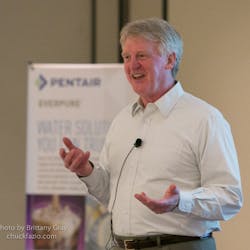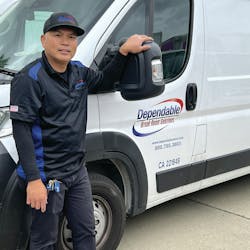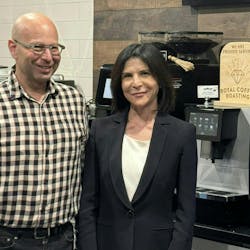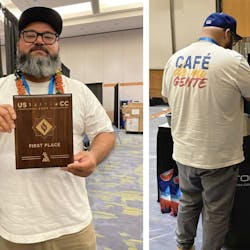Brewing coffee is an art form. The taste of a cup of coffee is determined by many things, including origin (elevation, amount of rain, shade, temperature), roasting (temperature, bean type) and brewing machine (water temperature, extraction). OCS operators who are hoping to compete in coffee must learn and understand the art and science behind the perfect brew, and how to deliver it to the customer. Mike Tompkins, industry veteran and president of Coffee Products Associates, shares three lessons he has learned on his journey to understanding coffee excellence.
Lesson 1: The trip from “black coffee” to specialty beverages
Just like every coffee bean has a unique story from how it got from origin to cup, industry professionals can tell the story of how they ended up working in such a fascinating business. Like many in the industry, my introduction to coffee began early on in life watching Grandma’s stovetop percolator. When I got my first job at McDonald’s in 1968 we made coffee in glass bowls from filter pouches in a Bunn-O-Matic and poured it out into Styrofoam cups, no matter how long it had been on the heater. At that time coffee was just a hot beverage I served. The concepts of “origin” and “flavor profile” didn’t exist for me. In fact, I didn’t even drink coffee.
It wasn’t until college that I began drinking the beverage out of the desperation to wake up. Even then, the drink was consumed out of a need, not in fondness.
A few years later, however, my eyes were opened to coffee the way Europeans drank it in 1976. On a flight to Europe I asked for “coffee” and the flight attendant replied with a one-word question “Nescafe?” She anticipated my soon-coming confusion, because she knew what I wanted, and she knew there was neither percolated coffee on-board nor probably anywhere in my European destinations. She was kindly preparing me by offering the only alternative: Nescafe — the ubiquitous European version of “American” coffee at the time. It wasn’t until I got to Paris that I had my first religious coffee experience. Along with my croissant I was given a huge bowl of steaming, creamy, coffee-smelling milk. This single incident changed my perception of coffee, and later circumstances would conspire to catch up my life in the art and science of preparing and serving specialty coffee beverages.
Operators today cannot assume that their customers remain inexperienced in coffee as I had been years ago. Just last year the National Coffee Association reported that coffee was the second most consumed beverage in the U.S.; past-day coffee consumption was nearly 60 percent. And consumers today are more aware of specialty and gourmet. In fact, according to Mintel the majority of coffee consumed in the U.S. is now specialty coffee.
In order to serve a ‘specialty coffee’, however, operators first have to understand the art and science behind what makes the beverages special.
The perfection of specialty coffees begins with unique genetic and agricultural origins of coffee plants and their cherries and seeds. The potentials of these seeds are enhanced by processing techniques and careful preparation, so that they may bear up under the transit from origin without losing their treasured essences. An appreciation for the distinct origins and flavors of coffee beans is a key part to being able to sell that bean to a location.
Lesson 2: The recovery from errors made
Not only is it important for operators in the OCS industry to understand the story behind the coffee they sell (or should sell), but one of the biggest lessons I learned was to pay attention to market trends surrounding coffee.
My first personal experience with Starbucks coffee was inauspicious. I was visiting an industry colleague in Philadelphia during the 1990s when he asked if I had tried Starbucks. Too hot and too dark, the cup inspired my proclamation: “This will never sell!” — the first of many confirmations of my unerring gift for predicting market trends by dismissing them. My colleague graciously overlooked my arrogance, and, insisting that this was a harbinger of things to come, disclosed a plan to launch a “specialty brand” developed for office coffee services. I remain in awe today for folks like that who really can detect the impulse of a wave in time to catch and ride it.
Suddenly, the excitement for specialty coffee was palpable. In that decade before the millennium, I became involved with the SCAA Technical Standards Committee, where I learned to appreciate the intricacies of controlling the processes that create quality beverages.
I learned about the agro sciences of growing and harvesting, processing and transporting which prepare and preserve the essences of the special coffee seeds — so that they might be transformed by the work of coffee roasters. I watched journeymen roasters select the nascent flavors and aromas from specifically chosen lots to marry with other elements of a union called simply “the blend.” The roast masters elevated the combined essences in the fires, and I experienced the perfection of the blend, which is father and mother to the beverage. And in the end I understood and helped to teach that these blends of specialty coffees deserve the intelligent application of specifically chosen technologies to extract a coffee liqueur worthy of all that careful planning and labor that went before.
I learned to love coffee. We wanted coffee extractions to bloom in the cup, unfolding aromatics like an exotic flower, inviting us to smell and sip and relish the indulgence of such a precious extravagance. I learned to appreciate fresh-roasted coffees that tasted like blueberries and lemons and espresso liqueur that oozed more than it flowed. Those who have smelled and tasted fresh ground coffees within the first or second day of the roast will testify to the intensity of their desire for the next experience of fresh.
All of us in the specialty coffee industry were bound up together by a vision of education and training a barista nation for a homeland of cafes, but would it be possible for someone to have that café experience at home or in the office? Specialty roasters strove to preserve that peak experience as their coffee traveled down to “the market.” One-way valve bags and door-to-store shipping of whole bean coffees conspired to deliver this freshness at coffee shops. Soon, a new potential emerged for the company that could deliver a convenient, specialty solution for homes and offices. Just as I had been skeptical about Starbucks early on, I was skeptical about the Keurig K-cup, too. I did not think that anyone would be willing to spend that amount of money on a cup of coffee brewed at home or in the office.
How badly I underestimated and stubbornly resisted the American compulsion for the speed of convenience! We don’t have the luxury of dismissing market trends, believing that they will go away. The need for freshness and convenient specialty beverages will only grow.
Lesson 3: Arriving at freshness and convenience
Keurig unleashed the pent up demand for a convenient “gourmet” solution. And despite their well intended commitments to freshness, their commitments to shareholders drove nearly every “gourmet” coffee roaster to buy the packaging licenses, gladly accepting the one-year expiration date in exchange for access to lucrative markets.
But the coffee houses had created a different latent market by exploiting an old American passion for a new kind of coffee-flavored milkshake: a shot of espresso smothered in steamed milk and sugar. Americans queued up for hot and cold specialty coffee beverages that we really could not make at home or in the office. So, we waited and hoped for espresso salvation, and right on cue: enter Nestle.
Even before Keurig encapsulated American “gourmet” coffees, Nescafe created espresso capsules and brewing systems as a retail solution for Europeans who wanted to brew a great shot of espresso at home or in the office.
Although the capsules were introduced to North Americans in the 1980s, our aversion to espresso shots delayed significant market penetration until Starbucks had primed the consumption of specialty beverages in the mid-1990s. Then, impossibly coincidental to the financial crisis and Internet fragmentation of traditional channels, espresso capsule consumption began to surge, increasing well over 50 percent in 2011.
Nestle was able to capture the essence of the coffee bean from origin and deliver it into a convenient format while appealing to the evolving American palate. This is shown in the fact that Nespresso sales in the U.S. topped $300 million in 2013 alone. Nestle executive Jean-Marc Duvoisin announced the deployment of a new capsule system to produce both 40 ml espresso shots and 8-ounce coffees. Although the tactic clearly intended to take market share from giants like Keurig, Duvoisin appealed to the attentions of potential investors by asserting that Nestle will be focusing on premium top quality coffee: “We don’t feel like we have direct competitors, we will be creating a new market.”
No matter how the wordsmiths say it, I will not error again in my entrenched arrogance of dismissing trends, now I will be shouting, “The capsules are coming! The capsules are coming!”
Mike Tompkins is president of Coffee Products Associates and has been the facilitator of the QCCP program since 2000. Named NAMA 2002 OCS Allied Member of the Year, Mike Tompkins consults with executives and employees of coffee services, bottled and POU water companies, vending services and retail operations in the U.S. and Canada to execute coffee marketing strategies by owning coffee expertise from bean to cup.






